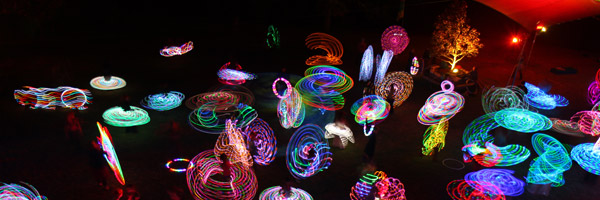The Hoop Mandala, 2011
 The Hoop Mandala Project was the world's first large-scale LED hoop mandala. The project was a collaboration between G. Craig Hobbs, Hoopcamp Retreats, Psihoops, and a Buddhist monastery - Pema Osel Ling. The project took place during the annual Hoopcamp Retreat at Pema Osel Ling in the Santa Cruz mountains in late September 2011.
The Hoop Mandala Project was the world's first large-scale LED hoop mandala. The project was a collaboration between G. Craig Hobbs, Hoopcamp Retreats, Psihoops, and a Buddhist monastery - Pema Osel Ling. The project took place during the annual Hoopcamp Retreat at Pema Osel Ling in the Santa Cruz mountains in late September 2011.
The Hoop Mandala was a large-scale buddhist artwork created using spinning, LED-illuminated hoops to generate living mandalas. Mandala is a sanskrit word that means "circle". In Tibetan and Hindu traditions, these circles appear as complex cosmological geometries that represent myriad aspects of human existence. Like traditional mandalas, the Hoop Mandala will represent the myriad artistry, talent, and magic of the hooping scene at Hoopcamp.
Participants in the Hoop Mandala formed 5 different mandalas. Hoopers were guided to their location within the mandalas using video projection mapping of symbols and dots on a large, open field. The hoopers were then guided into the mandalas through a serene, yogic voice and pulsing, meditative music. The mandalas developed in intensity over the course of the work moving from meditative rotations to full-on freestyle hooping.
Seen from a birds-eye view, the hoopers collectively created a wide range of swirling, multicolored patterns of light and form captured via a high-resolution, wide-angle video camera positioned 40 feet above the mandalas. The mandalas were documented in HD video and simultaneously projected on a large video screen for the hoopers to experience in real-time.
The Hoop Mandala was envisioned by G. Craig Hobbs as a visual offering of peace created in the form of a human meditation on the power and magic of the circle, and its rotation in and on the planet Earth. The work will be generated as a meditation on the buddhist concepts of metta (loving kindness), ahimsa (non-violence), and anitya (impermanence).
The project was funded the crowd-sourcing website Kickstarter here.